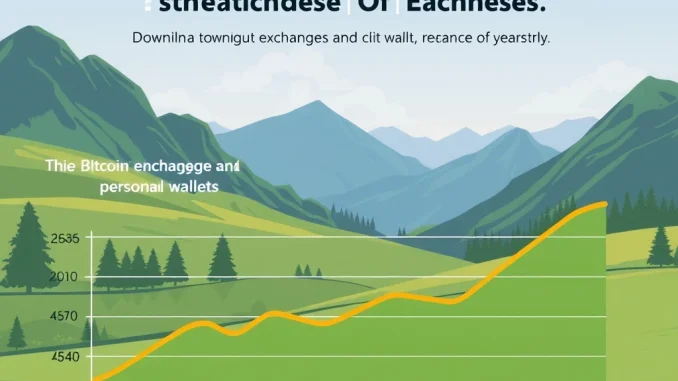
The world of Bitcoin is buzzing with a significant market signal that has caught the attention of analysts and investors alike. Recent data indicates a major shift in how holders are storing their digital assets. Specifically, the amount of Bitcoin supply on exchanges has reached a level not seen in seven years, suggesting a potential change in market dynamics.
What Does the Data on Bitcoin Supply on Exchanges Show?
According to insights provided by blockchain analytics firm CryptoQuant, the total supply of Bitcoin held on major cryptocurrency exchanges plummeted to a 7-year low. On April 25th, this figure stood at a mere 2.488 million BTC. While the supply has slightly edged up to 2.492 million BTC since then, the overall trend and the achievement of this historic low remain highly significant.
- 7-Year Low: The key takeaway is the specific figure of 2.488 million BTC reached on April 25th, representing the lowest exchange balance since 2017.
- Data Source: This metric is tracked and reported by reputable analytics platforms like CryptoQuant, which monitor wallet addresses associated with centralized exchanges.
- Current Status: The supply has slightly recovered but remains near this multi-year low, reinforcing the observed trend.
Why is Low BTC on Exchanges Considered Significant?
Understanding why the amount of BTC on exchanges is a crucial metric requires looking at the primary function of these platforms. Centralized exchanges are typically where users send Bitcoin when they intend to sell it, trade it for other assets, or speculate on short-term price movements. Conversely, when users plan to hold Bitcoin for the long term (often referred to as ‘HODLing’), they usually withdraw it from exchanges and store it in personal wallets, where they control the private keys.
Therefore, a decrease in the supply of Bitcoin on exchanges often suggests that a large number of holders are moving their coins *off* these platforms. This action signals an intent to hold rather than sell in the immediate future.
Exploring the Implications of Bitcoin Outflow
The trend of Bitcoin outflow from exchanges has several potential implications for the market:
When a significant amount of Bitcoin is moved off exchanges, it effectively reduces the readily available supply that can be sold onto the market. Less supply available for sale, assuming constant or increasing demand, can lead to upward price pressure. It indicates reduced selling pressure from exchange users.
High outflow rates are often interpreted as a sign that investors are entering an accumulation phase. They are buying Bitcoin and immediately moving it into cold storage or personal wallets, indicating strong conviction in the asset’s future value rather than preparing to sell.
This behavior reflects positive investor sentiment. It suggests that market participants believe the current price is attractive for long-term holding and are not fearful of an imminent price crash that would necessitate quick selling from an exchange.
What Do Reduced Bitcoin Holdings Suggest About the Market?
The reduction in aggregated Bitcoin holdings on exchanges provides a macro-level view of market participant behavior. It paints a picture where a large segment of the market is choosing to secure their assets for the long haul, rather than keeping them easily accessible for trading or selling on centralized platforms. This collective action of moving billions of dollars worth of Bitcoin off exchanges is a powerful signal of confidence in Bitcoin’s long-term prospects.
Insights from CryptoQuant Data
The data from CryptoQuant is instrumental in identifying these significant market trends. By tracking flows in and out of known exchange wallets, analysts can gain insights into the aggregate sentiment and intentions of Bitcoin holders. A sustained period of decreasing exchange balances, as highlighted by CryptoQuant’s 7-year low data point, is a strong indicator of a shift from speculative trading towards long-term investment and holding among a large portion of the market.
Conclusion: A Historic Signal
The fact that the Bitcoin supply on exchanges has fallen to a 7-year low is more than just an interesting statistic; it’s a historic signal from the market. It suggests that a significant amount of Bitcoin has been moved into private storage, reducing potential selling pressure and indicating a strong long-term holding conviction among investors. This trend of Bitcoin outflow, highlighted by data from CryptoQuant, points towards reduced Bitcoin holdings on trading platforms and potentially signals an accumulation phase and positive sentiment within the market. While not a guarantee of future price movements, it’s a metric that smart investors are watching closely as it reflects the underlying conviction of Bitcoin holders.



